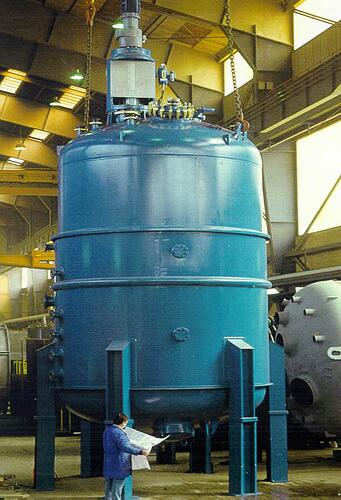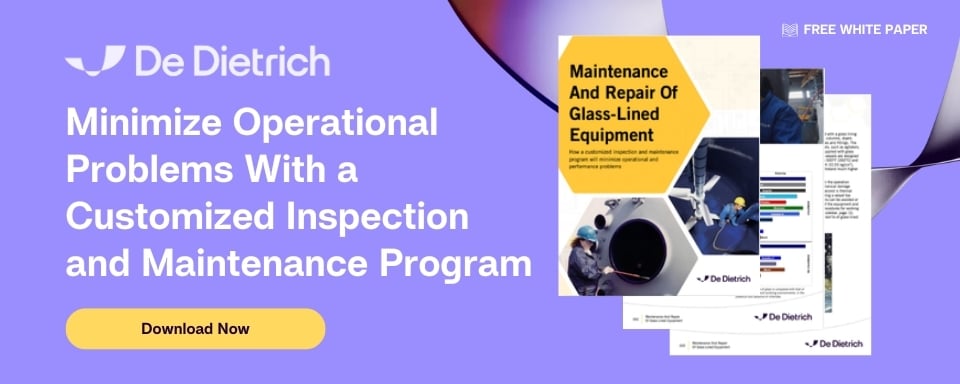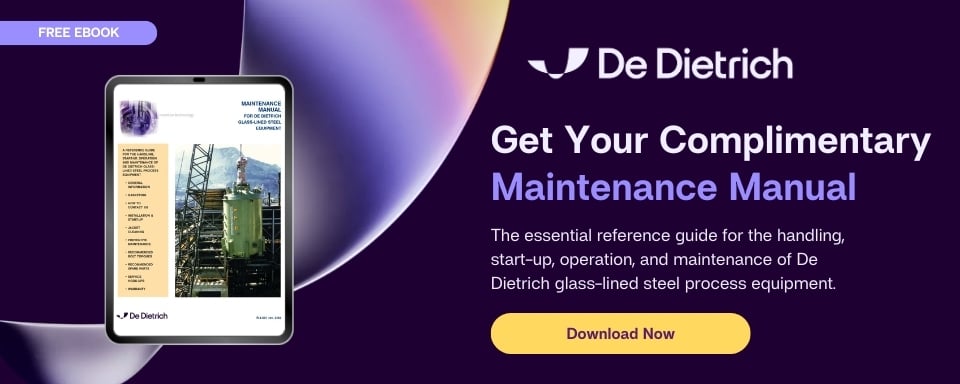Best Practices for Avoiding Damage in Glass-Lined Equipment (Part 2)
 In last week’s blog post we discussed two of the four main categories of failure modes that can occur in glass-lined equipment (mechanical and thermal). Today we’re going to pick up where we left off and continue the conversation with the remaining types of damage that can take place - electrical and chemical. Through educating yourself on the bad practices to avoid and familiarizing yourself with the good practices you can single-handedly prevent most failures from occurring…but it might not be a bad idea to share these articles with your colleagues to make sure everyone in your plant who handles glass-lined equipment is up to speed on the best practices.
In last week’s blog post we discussed two of the four main categories of failure modes that can occur in glass-lined equipment (mechanical and thermal). Today we’re going to pick up where we left off and continue the conversation with the remaining types of damage that can take place - electrical and chemical. Through educating yourself on the bad practices to avoid and familiarizing yourself with the good practices you can single-handedly prevent most failures from occurring…but it might not be a bad idea to share these articles with your colleagues to make sure everyone in your plant who handles glass-lined equipment is up to speed on the best practices.
The following data is excerpted from Materials Technology Institute’s Repair and Damage Assessment for Glass-Lined Equipment, written by Sal Falcone and Bert Moniz.
Electrical
Electrostatic Discharge
Bad practice: Allowing a static charge build up in agitated non-conductive liquids or falling powder additions may lead to breakdown of glass lining.
Good practices:
- Assessing spark potential with non-conductive solvents and when charging powders. Reducing agitation speed.
- Adding liquids through dip tubes so that they enter below the liquid level line.
- Incorporating water or soluble additives to increase solution conductivity
- Introduction of inert gas in the vapor space (nitrogen padding) to avoid explosion.
Spark Testing
Bad Practices:
- Using excessive spark testing voltages that exceed the capability of a glass lining.
- Conducting spark testing on thin non-stick linings used for polymer processing.
- Conducting spark testing at factory voltages of 15,000V to 20,000V.
Good practices:
- Conducting field testing at 50000-6000V maximum
- Conducting field testing at reduced voltages below 6000V if there is a loss of glass.
Chemical Attack - Glass
Minimum Available Glass Thickness
Bad practice: Ignorance of or failure to anticipate minimum thickness of glass required for corrosion resistance.
Good practices:
- Measuring glass thickness periodically for process environments that corrode glass.
- Exposing corrosion coupons in process environments that are corrosive to glass to estimate rate of attack.
Corrosion by Water
Bad practices:
- Using pure water for boil up or dummy running.
- Cleaning a pipe with soft or deionized water and keeping it there with heat tracing on.
Good practices:
- Adding a small amount of acid to the water.
- Insulating and/or heating the top head for hot processes to prevent rivulets of corrosive attack of the glass.
Corrosion by Acids
Bad practice: Failing to recognize the damaging effect of hydrofluoric, phosphoric or phosphorus acids.
Good practices:
- Investigating the presence of damaging acids or their ions in the process.
- Making use of manufacturers’ iso-corrosion charts when selecting glass for an application
Corrosion by Alkalis
Bad Practice: Failing to recognize damaging effect of hot alkali solutions on glass
Good practices:
- Anticipating the severity of alkali conditions in process.
- Always adding alkalis via dip tubes.
Corrosion by Salts
Bad Practice: Failing to recognize the potentially damaging effect of specific types of ions produced by salt solution.
Good practice: Anticipating effects of acid fluorides, chlorides, plus lithium, magnesium and aluminum.
Chemical Attack on Repair Materials
Degradation of Tantalum Patches and Plugs
Bad Practice: Allowing situations where tantalum may corrode or embrittle
Good practices:
- Checking for hydrogen damage of tantalum plugs and patches, and that they are not loose.
- Weld a platinum spot on a tantalum patch to prevent hydrogen embrittlement in certain applications.
Attack of Furan or Silicate Cements
Bad Practice: Using furan or silicate cements in process environments that attack it.
Good practice: Respecting the limitations and curing requirements of furan/silicate cement.
Damage to PTFE components
Bad practice: Failure to appreciate the physical capabilities of PTFE-protective liners or boots
Good practice: Replacing materials early enough, before underlying glass is damaged.
Chemical Attack on Steel
Corrosion from External Spills or Wet Insulation
Bad Practices:
- Allowing corrosive chemicals or powders to spill on external surface from sloppy charging of constituents to vessel.
- Allowing insulation to remain wet from hose-down or chemical spills.
Good practices:
- Maintaining leak-free flange makeup practices
- Neutralizing any are of acid or acid powder spill before washing and repainting
- Maintaining caulking in thermal insulation jacketing.
- Applying an immersion-grade coating to the top head region, including nozzles, instead of a non-immersion grade paint.
- Checking top head when spills are suspected and restore paint coating if rusting is suspected.
- Using dump chutes when loading corrosives through the manway.
- Applying stainless steel sheathing over insulation.
Damage from Chemical Cleaning of Jacket
Bad Practice: Allowing excessive corrosion of the vessel shell from acidic cleaning of the jacket, which can lead to spalling of glass.
Good Practice: Using a neutral cleaning agent, respecting longer time required for cleaning.
Flange Face Spalling
Bad Practice: Allowing flanges to leak and cause flaking of glass on the gasket face.
Good Practices:
- Using an effective flange make-up procedure to ensure a tight seal and no process leakage.
- Using alloy 600 overlay on flange face beneath glass lining.
We hope this information serves as an educational tool to help you make the right choices when operating and maintaining your glass-lined equipment. If you have any questions regarding any of these practices that are specific to your application please let us know and we’d be happy to help.


